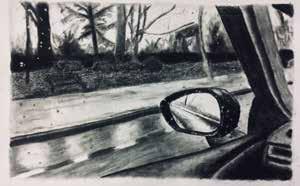
4 minute read
Art and Design: Fine Art
Art and Design: Fine Art Edexcel 1FA01
The GCSE Fine Art Course is designed to encourage an adventurous and enquiring approach to art and design. The course encourages pupils to demonstrate an understanding of past and contemporary art and design practice, and be able to produce personal artwork that embraces a range of ideas. Pupils have the chance to experiment with new media and techniques and encounter artworks and artists first-hand through workshops and trips.
What does the course involve? Component 1: Coursework
The coursework projects begin as soon as you start the course in Year 10. You will be given a project theme to work from, and you will begin by carrying out structured tasks to help you build up practical skills, carry out meaningful research and develop ideas towards one or more final outcomes. As your skills grow along with your confidence, you will have the opportunity to develop your project in a more personal direction and choose which materials, ideas and artists’ influences will help you do this, allowing you to explore your own interests in more depth. In the first term of Year 11, you will have the opportunity to improve and rework your coursework projects, which are worth 60% of the overall grade. Starting points for coursework projects are sufficiently broad to allow a personal, individual interpretation of the theme. Some previous coursework themes have been:
• Journal/Journey (exploring travel and artists’ journals) • Facing the World (self-portraiture) • I, Me, Mine (looking at still life and symbolism) • Botanical Forms (looking at form and pattern in the natural world)
Component 2: Examination Project
The theme for the Externally Set Assignment is given by the examination board in January of Year 11. You will have approximately 20 hours of lesson time, as well as outside lessons, to develop a personal approach to the theme. You will showcase the skills developed since the start of the course by producing both sketchbook work and larger responses over this ten-week period, ending in a 10 hour examination in which you will produce your final outcome.
The structure of the course is outlined below:
Component Timing Weighting Method of Assessment Requirement
1
2 Coursework Projects
Running from Yr 10 to April Yr 11
Externally Set Assignment
Running from January until April in Yr 11 60% Internally Set
Internally Marked Externally Moderated Supporting studies and outcomes must show evidence of
ALL Assessment Objectives
40% Externally Set Internally Marked Externally Moderated 20 Hours Preparation Time 10 Hours Timed Test
Key Stage 4 Guide
How will I be assessed?
You will receive regular written and verbal feedback on your work throughout the course. The course is structured in order to help you fully meet the criteria for assessment, and your work will be marked against these. All your work will be marked internally by your teacher, and externally moderated by a visiting examiner, who will have the final decision. In order to meet the assessment objectives, you must demonstrate that you can:

AO1
AO2 Develop your ideas through investigations informed by contextual and other sources, demonstrating analytical and cultural understanding. Refine your ideas through experimenting and selecting appropriate resources, media, materials, techniques and processes. 25%
25%
AO3 Record ideas, observations and insights relevant to your intentions in visual and/or other forms. 25%
AO4 Present a personal, informed and meaningful response demonstrating analytical and critical understanding, realising intentions and, where appropriate, making connections between visual, written, oral or other elements. 25%
What skills will I acquire?
You will be taught how to use traditional media and techniques, such as: • Painting (oils, acrylics, watercolours) • Drawing • Ceramics & Sculpture • Printmaking (Dry point, lino- printing and monoprinting) You will also be encouraged to introduce new media into your project work, such as digital photography, animation and drawing, using both the iPad and Mac computers available in the Morisot Art Library. You will build up transferable skills, such as the ability to research and write analytically, solve problems in a creative way, develop understanding of different historical and cultural contexts, and work in an independent, self-motivated way in order to meet deadlines.
Materials:
The Art department will provide all the materials and resources required for lessons. It is, however, recommended that pupils equip themselves with a good quality set of acrylics, watercolours, coloured crayons and drawing pencils, in order to be able to carry on sketchbook work and outcomes at home.
What goes on outside lesson times? Studio Sessions:
You will be expected to spend sufficient time working independently on your coursework and exam projects if you wish to succeed in Art, and you are encouraged to access the department facilities outside lesson time. These sessions allow pupils to share ideas, experiment with new techniques, as well as receiving feedback from teachers in a more informal environment.
Trips and Workshops:
In order to inform your project work, it is essential to experience artworks first-hand. There will be opportunities during the course to take part in museum trips and workshops. Pupils are also encouraged to make the most of our proximity to Paris to carry out gallery and museum visits in their own time.
The Exhibition:
At the end of the course, you will mount your work and organise and set up an exhibition. This not only allows the external moderator to see the work in its best light for the final mark, but is also a great way to allow others to appreciate the fruits of your labours. The exhibition is advertised to parents, pupils, and the local community, and is always well attended.










